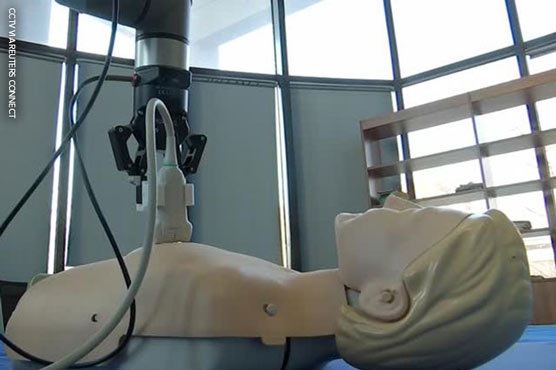Chinese professor designs robot for use on coronavirus wards

The team has a total of just two robots.
(Reuters) - A team of researchers at one of China’s top universities has designed a robot that they say could save lives during the coronavirus outbreak.
The robot, which more closely resembles a robotic arm on wheels, is designed to perform ultrasounds, mouth swabs and auscultation on coronavirus patients.
Such tasks are normally carried out in person by doctors, but when using the robot, which is fitted with cameras, doctors do not even need to be in the same room as patients.
They could even be a different city to the robot, the robot’s chief (technical) designer, Tsinghua University Professor Zheng Gangtie, told Reuters on Wednesday (March 4).
"Doctors are all very brave," Zheng said, "but this (virus) is just too contagious. We can use robots to perform the most dangerous tasks."
The idea of designing such a robot came to Zheng around the start of the Chinese New Year when he wanted to do something to contribute to the coronavirus relief effort and his friend, executive president of Tsinghua Changgung Hospital, Dr. Dong Jiahong, said that the biggest problem was doctors becoming infected.
Zheng set to work, calling in some students to help, and together with Dr. Dong and one other teacher, a team of ten or so converted two robotic arms into its robots. Initially the robots, which use the same technology used on space stations and lunar explorers, were almost entirely automated and independent. According to Zheng , they could perform temperature checks, give patients things like medicine and even self-disinfect after performing tasks where contact with patients was involved.
"But the feedback from doctors," Zheng said, "was that it would be best not to be so fully automated like this because there must be a person there next to the patient to comfort and calm them."
The team has a total of just two robots. Both have been trailed by doctors at hospitals in Beijing, Changgung and Ditan.
Currently, one is in the team’s makeshift lab beside the foyer of the Tsinghua University school of aerospace engineering. The other is at the Union hospital in Wuhan where doctors will receive training on the robot from Thursday (March 5), and if all goes to plan the robot may be used on actual coronavirus patients in Wuhan starting from this Sunday (March 8), Zheng said.
He says the feedback from doctors has been good. He would like to build more such robots but the funding from the university has run out. Their cost, at RMB 500000 (£55,792) apiece, could be a reason why. He does not plan on commercialising his robot design but hopes a suitable company comes along one day to do that.

